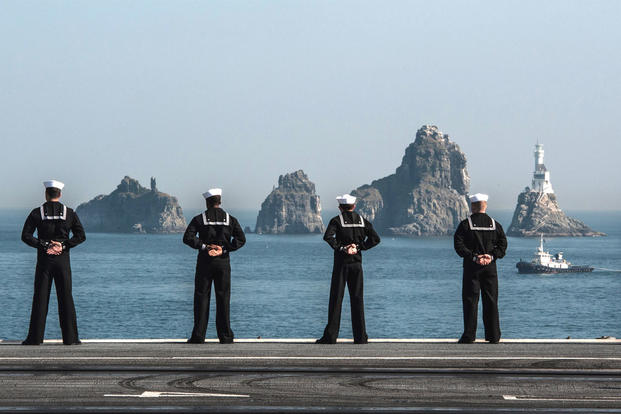After a pattern of deployments in recent years that have stretched to eight months and beyond, the Navy's top officer says the service is in shape to return to a seven-month deployment model by the end of 2016.
Speaking to an audience at the American Enterprise Institute in Washington, D.C. on Friday, Adm. John Richardson said he believed seven-month deployments represented a sustainable operational tempo from the standpoint of equipment maintenance, as well as personnel.
"We can get seven [months]. So that's our going-in model," Richardson said. "Now our responsibility to execute that plan, get through maintenance on time, get through the training cycle on time so you deploy ready from every aspect, that's what this optimized fleet response plan is doing."
That plan, first unveiled in January 2014, calls for carrier strike groups to operate within a three-year maintenance, training and deployment cycle designed to limit the length of deployments and boost readiness.
An abundance of missions and tight budget constraints have contributed to lengthening deployment cycles in recent years. The Bush Carrier Strike Group completed a nine-month deployment at the end of 2014, one of the longest in recent history for a CSG. In 2012, the Bataan Amphibious Ready Group spent nearly 11 months afloat in what was called the longest Navy deployment since World War II.
While those deployments represent more extreme lengths, eight-month floats have been more commonplace.
This trend has had a negative impact on readiness, Richardson said.
"We're still digging out of the trough that we've dug with the 10-month deployments, driving ourselves into readiness debt. And we're seeing that a bit across the board," he said.
Richardson said he was paying particular attention to managing the Navy's inventory of F/A-18 strike fighters, which have seen their service lives extended as the service prepares to transition to the F-35 Joint Strike Fighter amid delays.
To meet the seven-month deployment goal, Richardson noted it was crucial that the Navy got needed resources and maintenance as planned and anticipated.
"It's going to take predictable, sustained resources to get there," he said. "Any fluctuations in that, the amount or the uncertainty in the delivery of that, all those ripples get felt in the contracting actions and everything else that we need to do to return ships and people back to full readiness. So we just look for as much stability and predictability and adequate resources to recover that."
-- Hope Hodge Seck can be reached at hope.seck@military.com. Follow her on Twitter at @HopeSeck.



























